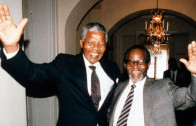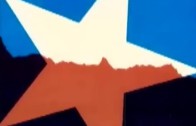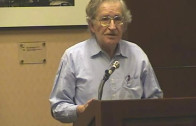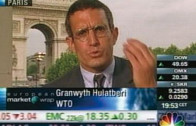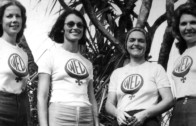Have You Heard From Johannesburg?
Have You Heard From Johannesburg? is series chronicling a history of the global anti-apartheid movement that opposed South Africa’s entrenched apartheid regime. The movement encompassed many methods, including mass action, underground organising, armed struggle, and international mobilisation. This series focuses on the last category: the movement to mobilise worldwide citizen action to isolate the apartheid regime. Inspired by the courage and suffering of South Africa’s people as they fought back against the violence and oppression of racism, foreign solidarity groups, in cooperation with exiled South Africans, took up the anti-apartheid cause. Working against the odds, in a climate of apathy or even support for the governments of Verwoerd, Vorster and Botha, campaigners challenged their governments and powerful corporations in the West to face up to the immorality of their collaboration with apartheid, revealing that the battle was more than just political. It was economic, cultural, moral, and spiritual. The combined stories have a scope that is epic in both space and time, spanning most of the globe over half a century. Beginning with the very first session of the United Nations, and ending in 1990–when, after 27 years in prison, Nelson Mandela, the best known leader of the African National Congress, toured the world, a free man.
Series
The first episode begins in 1948 when the United Nations adopted the Universal Declaration of Human Rights. That same year South Africa implemented a system of laws called apartheid to racially segregate its people in every aspect of life. The black majority in South Africa, led by the African National Congress, mounted the Defiance Campaign, attracting the attention of activists in places like England, Sweden, and the United States–and sowed the seeds of an international anti-apartheid movement. The world reacted with horror when peaceful protesters were shot in the South African township of Sharpeville and the entire African National Congress leadership was forced underground or imprisoned. Nelson Mandela is jailed for life, and the movement in South Africa is effectively shut down as hundreds escape into exile.
The second episode begins when African National Congress Deputy President Oliver Tambo escaped from South Africa into exile and embarked on what became a 30-year journey to engage the world in the struggle to bring democracy to South Africa. With resistance inside South Africa effectively crushed by the apartheid regime, the fate of the liberation struggle was in Tambo’s hands. He first found allies in the newly independent countries of Africa, and with their collective strength behind him, he approached the United Nations for support, insisting that the apartheid government could be forced to the negotiating table if the Security Council would sanction and isolate the regime. But the Western powers refused to act, forcing Tambo to search for new support. He successfully petitioned the Soviet Union for help in building a guerrilla army, a decision that landed Tambo and the African National Congress in the vice of the Cold War and haunted his global efforts for years to come. But two individuals helped to open crucial doors in the West: Olof Palme, Prime Minister of Sweden, and Archbishop Trevor Huddleston, whose early support inspired Oliver Tambo to seek out strategic partnerships with faith leaders worldwide. At the beginning of the 1970s, Tambo and the ANC had gained financing from Sweden and support from the World Council of Churches, whose members in congregations around the world joined the fight against apartheid. With these new allies on his side, Tambo had the beginnings of a worldwide movement.
It is youth, both inside and outside South Africa, who next joined the growing movement against apartheid. Buoyed by new support in Western countries, Oliver Tambo returned to the United Nations to try to convince the world body to sanction South Africa. His efforts gained new public support as the brutal suppression of a youth uprising in the South African township of Soweto and the controversial death of Steve Biko turned South Africa from a country into a cause, a worldwide emblem of injustice. In 1977 a significant victory was won when the United Nations issued a mandatory arms embargo: the first in history. But South Africa’s strongest trading partners in the West still would not sanction it economically, and as Tambo headed to Zambia to minister to the African National Congress’ growing guerrilla army, a bloodbath seemed inevitable. But even as the most powerful western governments refused to heed Tambo’s calls for cultural and economic boycotts, the citizens of those western nations would help turn the tide.
Athletes and activists around the world, faced with governments reluctant to take meaningful action against the apartheid regime, hit white South Africa where it hurts: on the playing field. International boycotts against apartheid sports teams help bring the human rights crisis in South Africa to the forefront of global attention and sever white South Africans’ cultural ties to the West. Knowing that fellow blacks in South Africa were denied even the most basic human rights–let alone the right to participate in international sports competitions–African nations refused to compete with all-white South African teams, boycotted the Olympics, and created a worldwide media spectacle that forced the International Olympic Committee to ban apartheid teams from future games. The Africa-led coalition steered the fight to exclude South Africa from soccer, boxing, track, cycling, judo, fencing, gymnastics, volleyball, and numerous other competitions, and barred South African teams from nearly all sports events by the 1970s. Only South Africa’s world champion rugby team remained, and citizens in key western countries where rugby is played took to the fields to close the last door on apartheid sports. The sports campaign became the anti-apartheid movement’s first victory and succeeded in culturally isolating the white minority in an arena of passionate importance.
This episode focuses on one of South Africa’s most important and powerful allies, the United States. It became a key battleground in the anti-apartheid movement as African-Americans led the charge to change the government’s policy toward the apartheid regime. A grassroots movement to get colleges, city councils, and states to divest their holdings in companies doing business in South Africa spread across the entire nation pressuring the United States Congress to finally sanction South Africa. This stunning victory is won against the formidable opposition of President Ronald Reagan. African-Americans significantly altered U.S. foreign policy for the first time in history. European sanctions followed, and with them, the political isolation of the apartheid regime.
The sixth episode is the story of the first-ever international grassroots campaign to successfully use economic pressure to help bring down a government. Recognising the apartheid regime’s dependence on its financial connections to the West, citizens all over the world, from employees of Polaroid, to a General Motors director; from student account-holders in Barclays Bank to consumers who boycott Shell gas; all refused to let business with South Africa go on as usual. Boycotts and divestment campaigns brought the anti-apartheid movement into the lives and communities of people around the world, helping everyday people understand and challenge Western economic support for apartheid. Faced with attacks at home and growing chaos in South Africa, international companies pulled out in a mass exodus, causing a financial crisis in South Africa and making it clear that the days of the apartheid regime were numbered.
The final episode dives into the centre of the conflict. South Africans tell the story of the most important effort in the anti-apartheid campaign of the 1980’s: the alliance that brought together anti-apartheid forces in South Africa as never before. A mass movement gained unprecedented momentum when three generations of resistance fighters band together as the United Democratic Front. Faced with growing international isolation, the apartheid government tried to win allies and convince the world of the merit of its piecemeal reforms even as it struggled to suppress open revolt, at times using savage secret tactics. The United Democratic Front protests climaxed in a new Defiance Campaign, and internationally, Nelson Mandela became a household name as the campaign to free him ignited a worldwide crusade. Caught between an unstoppable internal mass movement and ongoing international pressure, the apartheid regime was finally forced to the negotiating table and at last lifts the decades-long bans on the African National Congress. After twenty-seven years in prison, Nelson Mandela was released, sparking a global celebration as he toured the world to thank all. After 30 years in exile, Oliver Tambo was finally able to return to South Africa. But the struggle had taken a heavy toll on him and he would die one year before his comrade, Nelson Mandela, is elected the first black president of a democratic South Africa.
